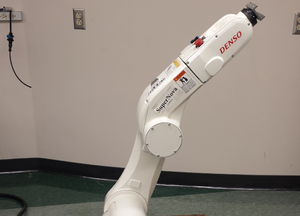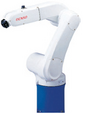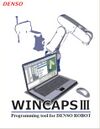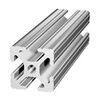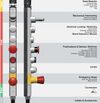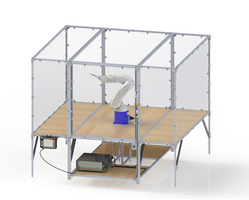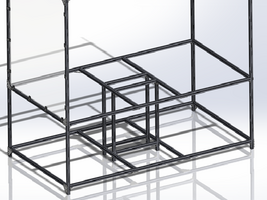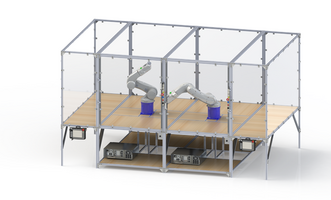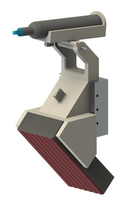Robotic Workstation
| The Denso robotic arm in action. | |
| Sponsors | |
| Team Name | Roboshow |
| Team Members | Kevin Witkoe, Will Edwards, Jacob Herrington, Kyle Kausen, Andrew Gregory, Stephen Goodwin |
| Duration | Fall 2013 - Spring 2014 |
| Faculty Advisers | David Alexander |
| Mentor | David Eld |
The Roboshow Senior Design team was tasked with designing the safety enclosure and workstation for one of the Denso robots. The purpose is to showcase the robots capabilities to students, faculty, and visitors and provide a safe and reliable research platform for advancing robotic technologies.Our goal is for the robot enclosure have a lasting influence on the engineering department by advancing graduate research and providing applied teaching to undergraduates. We also want the robot to be a showcase to attract future students.
Background
In the spring of 2013, The Boeing Company generously donated multiple Denso robot arms to the College of Engineering of the University of Idaho. These lightweight, compact robots are designed for a wide-range of industrial and manufacturing applications. A description of Denso’s VS-G series can be found here: http://www.densorobotics.com/products/vs-g-series/features. The Mechanical & Electrical Engineering departments are currently exploring ways in which to incorporate these robots in the curriculum and to make them available for academic and sponsored research. During the first stage of this process, the departments are looking to grow institutional knowledge through the development of a mobile robotic research station.
Design Task
The task is to design and build a portable industrial robot research station featuring a Denso Robotic Arm. The completed design should include a mobile platform for the robot arm, including a transparent safety enclosure, an installed and tested teaching pendant and controller software, and an end-effector for use in a demonstration of the robot’s capabilities. We are tasked to design a safety enclosure that conforms to industrial best practices and applicable standards and demonstrates relevant academic and research activities during high visibility university events.
Design Specifications
Enclosure Design
Relatively mobile
- Have wheels or ability to be transported
- Easy to move, and disassemble
Multiple Safety redundancies
- Door Switches, Light Curtain, Protective glass/wire mesh, and emergency stop button
Modular
- Easy to replicate for future projects and combine with other enclosures
Integrated controller storage
- Industrial electronic storage box, RC7 controller mount
- Storage under enclosure
Expandable to multiple robots Fit within freight elevator
- Max dimensions to fit are 46”x84”x78”
Arm must fully extend in x,y, and z directions without collision
- Full extension should include length of the end effector
- Arm X and Y radius is 34”
- Arm max height is 43”
User interface
- Start and stop programs
- Allow external control using PC
Concept Devolopment
Timeline
2/21/14 Design Review
- Finalized enclosure design
- End effector design options
3/11/14 3rd Snapshot
- End effector prototype
3/31/14
- Enclosures assembled
5/2/14 Engineering Expo
5/9/14 Client Handoff
- Operation Manual finished
Parts
| Design | Description |
|---|---|
| The robotic arm is a standard industrial arm.The model we are using is the VS-6577GM-B[1].The VS-Series six-axis articulated robots combine high speed and repeatability with powerful load-handling capability. They have a 7 kg maximum payload capacity and a maximum allowable moment of inertia (0.295 kgm² at J4 and J5, and 0.045 kgm² at J6). This enables flexible end-effector designs and a wide range of applications. In addition, the VS-Series footprint is only 200 x 200 mm, facilitating integration. The VS Series is ANSI and CE compliant. | |
| DENSO's WINCAPS III offline programming software enables users to conveniently program a robot from a remote PC without operating the robot[2]. WINCAPS gives an environment to run 3D simulations of programs to verify operations. Realtime robot movement can also be monitored when the PC is connected to the controller. WINCAPS allows programs to be easily uploaded to the controller and read from the pendant.3D objects can be imported to more accurately model simulations. WINCAPS also gives extensive vision support built in to programming. | |
| The controller is the brain of the whole system. It routes power to everything else and communicates with the safety system to shut off power. The main function of the RC7 controller is processing programs that are sent to the robotic arm[3]. The RC7 weighs less than 50 lbs. and is only 440 mm w. x 425 mm d. x 157.5 mm h[4].
It uses 240V three phase or single phase connections. The controller stores programs and controls processes and the I/O from any devices[5]. | |
| The teaching pendant is essentially the GUI of the controller. Allowing users to easily navigate programs,set and monitor I/O, and manually manipulate the robot. It features a larger 7.5-inch color touchscreen with customizable display and a larger deadman switch, as well as a jog dial for scrolling.[6]. Anything that can be done in WINCAPS can also be done on the pendant. |
| Design | Description |
|---|---|
| 80/20 may be used as the frame for the enclosure. 80/20 is a framing system using extruded beams of 6105-T5 aluminum alloy[7].80/20's T-Slotted aluminum profiles have a yield strength of 35,000 lbs./ sq. in. minimum.It keeps the structure strong enough to support the weight required while giving flexibility.[8] The enclosure uses 1" 80/20. | |
| Polycarbonate sheets will be used on the viewing sides of the enclosure. The sheets are transparent and impact resistant to ensure safe operation. 1/8" is used for the enclosure. |
| Design | Description |
|---|---|
| The eGard is a modular safety device that effectively regulates external control and safety features. Each module may contain a different safety feature. So far the eGard includes: emergency stop with key lock,step stop,start,operating light,program selector, and a solenoid locking actuator for the door.All of them are wired through a 14 pin connector which connects to the controller safety I/O. The auto/manual switch is also connected with the controller next to the eGard. Currently the eGard still has two empty spots for additional modules. |
Previous Safety Features
Our previous ideas for safety are either replaced in functionality by the eGard or dropped from the project due to cost. One of the first things we wanted was a safety light curtain. It would shut off the robot if anything passed through the light gates; however it would use to much of the budget and could just be replaced with polycarbonate. Before we found the eGard, we were looking at individual safety modules which would be connected by relays, but the eGard has everything we need and is in one system.
Demonstration
While building the enclosure, we developed programs that write on a whiteboard. We wired the the safety controls to run the robot in a controlled environment without the enclosure initially.We have been testing programs in WINCAPs then using the pendant to run them. So far, we successfully ran a number of programs including: drawing a sine wave, drawing an I,drawing a circle, and drawing the vandals logo.To visually see the programs, a whiteboard frame and marker holder were developed so that the robot can actually draw on the whiteboard.Upon completion of the enclosure, the robot was inserted with the whiteboard and a new end-effector that includes an eraser. The programs were modified to accommodate the new position of the whiteboard, and they ran successfully.
Enclosure
Current Design
3 Piece Design
|
|
|
|
The design was chosen for functionality as well as aesthetics. The polycarbonate keeps everyone safe but allows a full viewing and teaching experience with the robot. The robot will be moved only occasionally so simple parts are favored over complex deconstruction methods. The three piece design has one main piece and two side pieces. The main piece is larger and holds the robot as well as the electronic equipment below the robot platform. The two side pieces hang on opposite sides of the central piece. The design is simple and uses fewer parts. Fewer parts make disassembling and regular maintenance easy.The frame also features 80/20 on the base to allow the robot's origin to be moveable. To save on cost the prototype is using plywood for the base.
Safety Measures
Safety is a major concern with the enclosure. We researched and incorporated OSHA and NFPA standards into our design to give a more professional level of safety. The main safety system is regulated through the eGard. The eGard also supports switching from the computer to the teaching pendant with a toggle switch.
End Effector
We want an easy to implement and relatively simple end effector for research these are the basic designs we explored. However, there wasn't room in the budget for a professional end effector so we adapted our design for what we had. For future projects, a new end effector is recommended. When looking at price, it is better to buy a manufactured end effector than build our own.The purchasable end effectors can be selected based on future research needs.
Current End Effector
The end effector we chose was selected due to budget and demonstration needs. Most of the showcase programs drew on the whiteboard. The design added an eraser for quick board clearing and kept the spring-loaded marker to ensure contact with the board. It was 3D printed which made it inexpensive and custom to our needs.
Previous Designs and options
Two Piece Design
Our first conceptual design was the two piece design.The two piece design uses two identical sides to make up the enclosure. Separation of the enclosure is needed to fit on the service elevator for transport. The partitions are depicted above. The robot is affixed to both sides in the center.The front and back use polycarbonate sheets and a wire mesh is used for the doors. The lower portion of the design will store the controller and safety equipment on one side. The other side can store objects for demonstration such as an armature. Caster wheels are used on the bottom.
Collapsible Design
The collapsible design is made of one central piece with two attached sides. The design is similar to the 3 piece, but instead of having sides that can be removed, the sides collapse to minimize space like an accordion. The sides also have supports that reach the ground instead of hanging, but still remove the shelving on the lower portion.
Design Options
Safety light curtain
We have decided that the light curtain was not cost effective for the project but it may be beneficial for other projects.The safety light curtain can be used to have a completely open viewing area on one side of the enclosure. A problem is if the robot is manipulating an object the curtain can't stop the object if it is thrown past. To fix this, we can use a detachable polycarbonate sheet when objects are being used otherwise leave it off.
Top of enclosure
The design of the top was difficult to decide because it can still conform to standards without a top. The top shouldn't interfere with visibility, but a top may be wanted to keep objects out. However the enclosure is already tall enough that it would be difficult to put an object over the top. As a result, we left the top open.
Base
We have decided to use legs instead of wheels however there are some tradeoffs. The base design can use wheels or just legs on the ground. With wheels, the enclosure can be pushed around anywhere. Another option is just have it lifted by a jack and transported. Getting rid of the wheels would improve stability but might hurt mobility since some parts would need to be carried until we got them to a jack.
Multiple safety redundancies
We do want multiple fail-safes but we want to design around an informed operator currently. We use safety procedures to supplement a lack of automatic safety checking. For example, instead of having magnetic switches on the sides we can just have the operator perform safety checks on the sides.
Team Experience
Our Team
| Member | Major | Bio |
|---|---|---|
| Kevin Witkoe |
ME | I am currently a senior studying Mechanical Engineering at the University of Idaho. I grew up in Spokane, Washington and have lived there my entire life. My academic interests include robotics and machine design. I have been participating in undergraduate research in those areas. For the past two summers I have been an intern at NASA’s Jet Propulsion Laboratory in Pasadena, California. While I was there, I worked on a lunar exploration robot and a robot capable of maneuvering on Near Earth Asteroids. After graduation, I plan on pursuing a career that focuses heavily on design. I intend to build a career in robotics or machine design. I anticipate earning my master’s degree in mechanical engineering but first would like to gain some real world experience. I’m ready to go where life takes me and I’m excited for that the future has in store. |
| Will Edwards |
ME | Will is currently a senior in mechanical engineering from Bonney Lake, Washington. He has spent his last two summers interning at Stryker Endoscopy in San Jose, California where he worked as both a test and a design engineer helping to develop new medical device products. During the school year, Will works as a computer technician for GeekInspect Computer Repair in Moscow, Idaho. He loves many sports including soccer, baseball, and cross country and is an avid mountain biker and snowboarder in his spare time. Will will be graduating in the Spring of 2014. |
| Jacob Herrington |
EE | Jacob is a senior in electrical engineering from St. Maries,ID. He is interested in digital controls and processing and is a member of IEEE. He is graduating in Fall 2014.In his free time he likes to play sports and compete with friends. |
| Kyle Kausen |
CompE | Kyle Kausen is a senior in computer engineering from Coeur D’ Alene, ID. He is a well rounded individual who strives to reach excellence in academics along with having fun. In his spare time he loves playing a variety of sports such as golf, baseball, football, etc. He looks forward to graduating in Spring 2014 and starting a new chapter of his life. |
| Andrew Gregory |
ME | Andrew is a senior in Mechanical Engineering from Caldwell, Idaho. He is a member of Tau Beta Pi Honor Society, and ASME (American Society of Mechanical Engineers). Andrew is attending graduate school in the fall of 2014. In Andrew’s free time he likes to hunt, and fly fish. |
| Stephen Goodwin |
ME | Stephen is currently a senior in Mechanical Engineering from Hayden, ID. His academic interests include areas of robotics, controls, and system dynamics. During the last few years, he has participated in many design and research projects such as Idaho RISE and ASME Microbaja. During the summer of 2013 he interned at NASA’s Jet Propulsion Laboratory, working on micro robotic applications. After graduating in the spring of 2014, he plans on pursuing a graduate education with the hope of one day becoming a professor. Outside of the classroom he enjoys hiking, camping, ultimate frisbee, and many other activities. |
External Links
References
Resources
Denso VSG Series Robot datasheet
Creating a Simulation in Wincaps III
Team Documents
